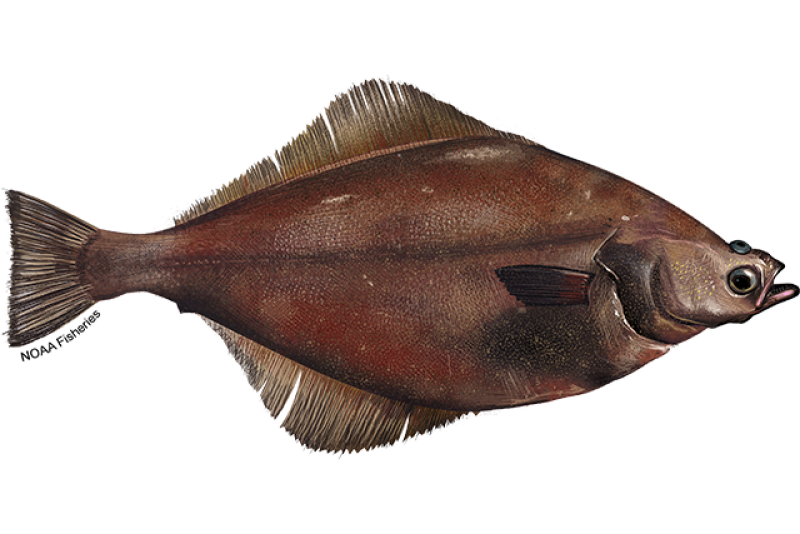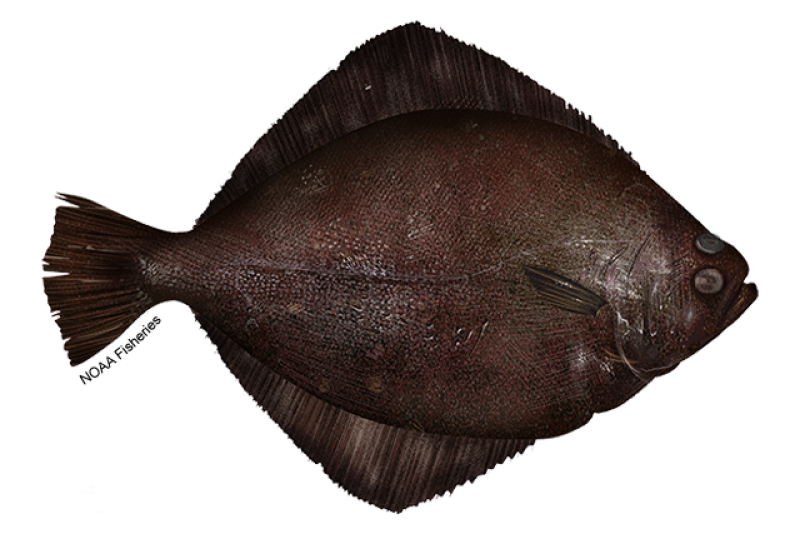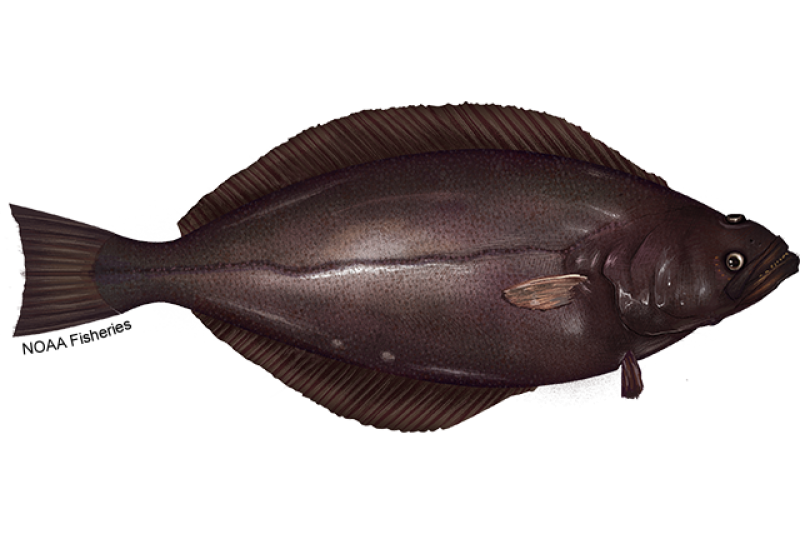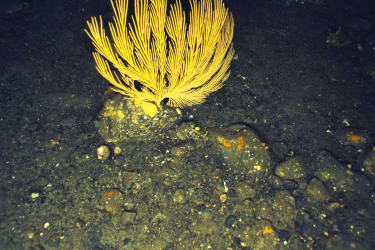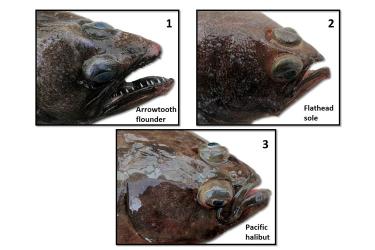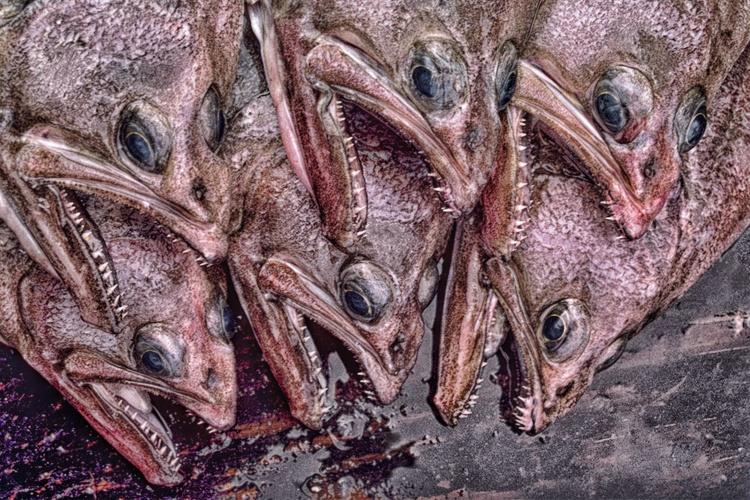 Arrowtooth flounder. Credit: NOAA Fisheries
Arrowtooth flounder. Credit: NOAA Fisheries
Arrowtooth flounder. Credit: NOAA Fisheries
About the Species
 Arrowtooth flounder. Credit: NOAA Fisheries
Arrowtooth flounder. Credit: NOAA Fisheries
Arrowtooth flounder. Credit: NOAA Fisheries
U.S. wild-caught arrowtooth flounder is a smart seafood choice because it is sustainably managed and responsibly harvested under U.S. regulations.

Population
The stocks are not overfished.

Fishing Rate
Not subject to overfishing.

Habitat Impact
Area closures and gear restrictions protect habitats affected by some types of fishing gear used to harvest arrowtooth flounder.

Bycatch
Regulations are in place to minimize bycatch.
Population Status
- There are three stocks of arrowtooth flounder: Bering Sea/Aleutian Islands, Gulf of Alaska, and Pacific coast. According to the most recent stock assessments:
- The Bering Sea/Aleutian Islands stock is not overfished (2022 stock assessment) and not subject to overfishing based on 2023 catch data. Summary stock assessment information can be found on Stock SMART.
- The Gulf of Alaska stock is not overfished (2022 stock assessment) and not subject to overfishing based on 2023 catch data. Summary stock assessment information can be found on Stock SMART.
- The Pacific coast stock is not overfished (2021 stock assessment) and not subject to overfishing based on 2022 catch data. Summary stock assessment information can be found on Stock SMART.
Appearance
- Arrowtooth flounder are a relatively large, brownish colored flatfish with a large mouth.
- They’re members of the family Pleuronectidae, the right-eyed flounders, which have both eyes on the right side and lie on the ocean floor on their left side.
Biology
- Arrowtooth flounder grow slowly and can live up to 27 years.
- Males can reach 2 feet in length, and females grow a bit larger, up to almost 3 feet.
- Males sexually mature when they reach 3 to 7 years old, and females are able to reproduce when they reach 4 to 8 years old.
- Spawning season varies by location:
- Off the West Coast from late fall through early spring.
- In the Gulf of Alaska during spring and summer.
- Off the coast of Alaska during fall and winter.
- They spawn multiple times during a spawning season, releasing eggs that are then fertilized externally.
- Arrowtooth flounder eggs hatch in deep water (below 400 meters) and rise up the water column as they develop, then settle to the ocean bottom during the summer and fall.
- Larvae eat copepods, a type of small crustacean.
- Juveniles and adults feed on crustaceans (mainly pink shrimp and krill) and fish (mainly cod, herring, and pollock).
- A variety of fish and marine mammals prey on arrowtooth flounder, including skates, sharks, shortspine thornyhead, halibut, orcas, other toothed whales, and harbor seals.
- In the Gulf of Alaska, arrowtooth flounder are an important part of the diet of Steller sea lions.
Where They Live
Range
- Arrowtooth flounder are found from Northern California through the Bering Sea.
Habitat
- Juvenile and adult arrowtooth flounder live on the ocean floor.
- They’re most commonly found on sand or sandy gravel habitat and occasionally over low-relief rock-sponge bottoms.
- During the summer, arrowtooth flounder feed in shallow water on the continental shelf.
- They migrate to deep water over the continental slope to spawn in the winter.
Fishery Management
- NOAA Fisheries and the North Pacific Fishery Management Council manage the arrowtooth flounder fishery in Alaska.
- Managed under the Gulf of Alaska and Bering Sea/Aleutian Islands Groundfish Fishery Management Plans:
- Arrowtooth flounder are included in these fishery management plans because of their importance to the ecosystem (it’s a very abundant flatfish and an important part of the food chain as both predator and prey).
- Commercial interest in arrowtooth flounder has grown in recent years.
- Limit on the total amount of arrowtooth flounder that can be harvested each year. Annual harvests have consistently been below this level.
- NOAA Fisheries and the Pacific Fishery Management Council manage the arrowtooth flounder fishery on the West Coast.
- Managed under the Pacific Coast Groundfish Fishery Management Plan:
- Limits on the number of permits and fishermen allowed.
- Limits on the minimum size of fish that may be harvested.
- Limit on how much may be harvested in one fishing trip.
- Certain seasons and areas are closed to fishing.
- Gear restrictions help reduce bycatch and impacts on habitat.
- A trawl rationalization catch share program includes:
- Catch limits based on population information for each fish stock and divided into shares that are allocated to individual fishermen or groups.
- These fishermen can decide how and when to catch their share—preferably when weather, markets, and business conditions are most favorable, allowing the fishery the flexibility to be more environmentally responsible, safer, more efficient, and more valuable.
Harvest
- In 2023, commercial landings of arrowtooth flounder totaled 32.4 million pounds and were valued at $4 million, according to the NOAA Fisheries commercial fishing landings database.
- Although arrowtooth flounder are a low-value fish, fishermen have been retaining more of the arrowtooth they catch—up to about 80 percent in Alaska.
- Catches have been higher because arrowtooth flounder are more abundant, resulting in higher incidental catch in other fisheries, in addition to increased marketing efforts for arrowtooth fish meal and surimi.
- Gear types, habitat impacts, and bycatch:
- Bottom trawl gear is used to catch arrowtooth flounder.
- In general, arrowtooth flounder live on sandy or sand/gravel habitats. These soft bottom habitats are usually more resilient than other habitats to trawling impacts.
- In Alaska, NOAA Fisheries scientists and the flatfish fishing industry collaborated to develop changes to fishing gear that would reduce effects of flatfish trawling on seafloor habitats of the central Gulf of Alaska and the eastern Bering Sea shelf. The modified gear they developed – Bering Sea flatfish gear – not only reduced impacts to sea floor habitat and the animals living there but also reduced the fishery’s impacts on crabs. In the central Gulf of Alaska and Bering Sea areas, flatfish fishermen are now required to use this modified fishing gear.
- Halibut are sometimes incidentally caught, but there is a limit on the number of halibut that can be incidentally caught in the fishery. When this limit is reached, the directed fishery is closed.
- Some rockfish are still unintentionally caught, but management caps the amount of rockfish that can be incidentally caught in the fishery.
- To protect sensitive fish habitat off the West Coast, gear restrictions limit where flatfish fishermen can fish.
Scientific Classification
- Arrowtooth flounder are found from Northern California through the Bering Sea.
- Juvenile and adult arrowtooth flounder live on the ocean floor.
- They’re most commonly found on sand or sandy gravel habitat and occasionally over low-relief rock-sponge bottoms.
- During the summer, arrowtooth flounder feed in shallow water on the continental shelf.
- They migrate to deep water over the continental slope to spawn in the winter.
Fishery Management
- NOAA Fisheries and the North Pacific Fishery Management Council manage the arrowtooth flounder fishery in Alaska.
- Managed under the Gulf of Alaska and Bering Sea/Aleutian Islands Groundfish Fishery Management Plans:
- Arrowtooth flounder are included in these fishery management plans because of their importance to the ecosystem (it’s a very abundant flatfish and an important part of the food chain as both predator and prey).
- Commercial interest in arrowtooth flounder has grown in recent years.
- Limit on the total amount of arrowtooth flounder that can be harvested each year. Annual harvests have consistently been below this level.
- NOAA Fisheries and the Pacific Fishery Management Council manage the arrowtooth flounder fishery on the West Coast.
- Managed under the Pacific Coast Groundfish Fishery Management Plan:
- Limits on the number of permits and fishermen allowed.
- Limits on the minimum size of fish that may be harvested.
- Limit on how much may be harvested in one fishing trip.
- Certain seasons and areas are closed to fishing.
- Gear restrictions help reduce bycatch and impacts on habitat.
- A trawl rationalization catch share program includes:
- Catch limits based on population information for each fish stock and divided into shares that are allocated to individual fishermen or groups.
- These fishermen can decide how and when to catch their share—preferably when weather, markets, and business conditions are most favorable, allowing the fishery the flexibility to be more environmentally responsible, safer, more efficient, and more valuable.
Harvest
- In 2023, commercial landings of arrowtooth flounder totaled 32.4 million pounds and were valued at $4 million, according to the NOAA Fisheries commercial fishing landings database.
- Although arrowtooth flounder are a low-value fish, fishermen have been retaining more of the arrowtooth they catch—up to about 80 percent in Alaska.
- Catches have been higher because arrowtooth flounder are more abundant, resulting in higher incidental catch in other fisheries, in addition to increased marketing efforts for arrowtooth fish meal and surimi.
- Gear types, habitat impacts, and bycatch:
- Bottom trawl gear is used to catch arrowtooth flounder.
- In general, arrowtooth flounder live on sandy or sand/gravel habitats. These soft bottom habitats are usually more resilient than other habitats to trawling impacts.
- In Alaska, NOAA Fisheries scientists and the flatfish fishing industry collaborated to develop changes to fishing gear that would reduce effects of flatfish trawling on seafloor habitats of the central Gulf of Alaska and the eastern Bering Sea shelf. The modified gear they developed – Bering Sea flatfish gear – not only reduced impacts to sea floor habitat and the animals living there but also reduced the fishery’s impacts on crabs. In the central Gulf of Alaska and Bering Sea areas, flatfish fishermen are now required to use this modified fishing gear.
- Halibut are sometimes incidentally caught, but there is a limit on the number of halibut that can be incidentally caught in the fishery. When this limit is reached, the directed fishery is closed.
- Some rockfish are still unintentionally caught, but management caps the amount of rockfish that can be incidentally caught in the fishery.
- To protect sensitive fish habitat off the West Coast, gear restrictions limit where flatfish fishermen can fish.
Scientific Classification
| Kingdom | Animalia | Phylum | Chordata | Class | Actinopterygii | Order | Pleuronectiformes | Family | Pleuronectidae | Genus | Atheresthes | Species | stomias |
|---|
Last updated by NOAA Fisheries on 03/21/2025
Featured News
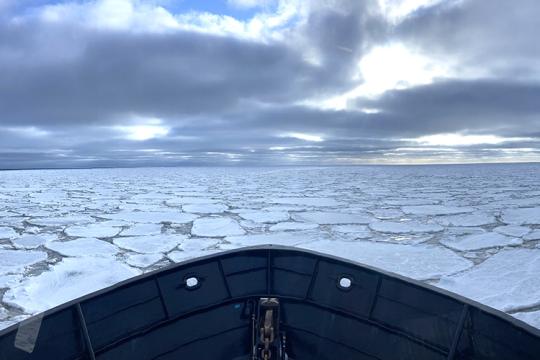 The research vessel Norseman II pushes carefully through the ice, maneuvering for open water. Credit: Gavin M Brady/NOAA Fisheries.
The research vessel Norseman II pushes carefully through the ice, maneuvering for open water. Credit: Gavin M Brady/NOAA Fisheries.
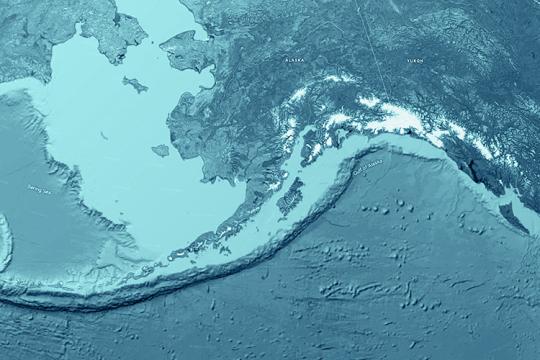 3D render and imaging of topographic map of Alaska showing the Gulf of Alaska, Aleutian Islands and Bering Sea. Satellite images courtesy of NASA. Credit: Frank Ramspott
3D render and imaging of topographic map of Alaska showing the Gulf of Alaska, Aleutian Islands and Bering Sea. Satellite images courtesy of NASA. Credit: Frank Ramspott
 Offloading frozen Pacific cod from a catcher-processor vessel in Dutch Harbor, Alaska. Credit: NOAA Fisheries / Paul Hillman.
Offloading frozen Pacific cod from a catcher-processor vessel in Dutch Harbor, Alaska. Credit: NOAA Fisheries / Paul Hillman.
Economic Snapshot Shows Alaska Seafood Industry Suffered $1.8 Billion Loss 2022–2023
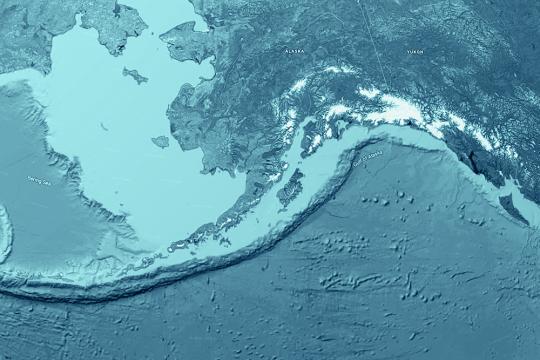 3D render and imaging of topographic map of Alaska showing the Gulf of Alaska, Aleutian Islands and Bering Sea. Satellite images courtesy of NASA. Credit: Frank Ramspott
3D render and imaging of topographic map of Alaska showing the Gulf of Alaska, Aleutian Islands and Bering Sea. Satellite images courtesy of NASA. Credit: Frank Ramspott
Seafood Facts

Is Arrowtooth Flounder Sustainable?
U.S. wild-caught arrowtooth flounder is a smart seafood choice because it is sustainably managed and responsibly harvested under U.S. regulations.
Availability
Year-round.
Source
U.S. wild-caught from Alaska to California.
Taste
Mild, sweet flavor.
Texture
Delicate.
Color
Arrowtooth flounder meat is white.
Health Benefits
Flounder is a good, low-fat source of B vitamins and niacin.
Nutrition Facts
Servings: 1; Serving Weight: 100 g; Calories: 91; Protein: 18.84 g; Total Fat: 1.19 g; Total Saturated Fatty Acids: 0.283 g; Carbohydrate: 0 g; Total Sugars: 0 g; Total Dietary Fiber: 0 g; Cholesterol: 48 mg; Selenium: 32.7 mcg; Sodium: 81 mgFlounder Recipes
Looking for some ways to add flounder into your rotation? If you need some cooking inspiration, browse these recipes for baked flounder with herbs, stuffed flounder, and more!
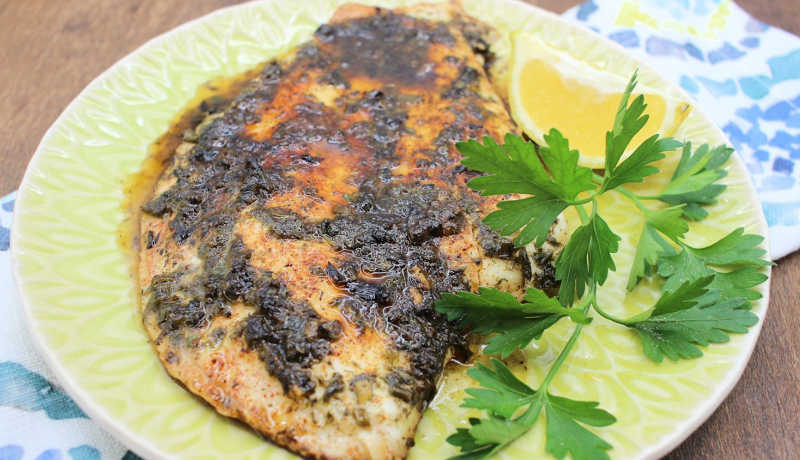
Last updated by NOAA Fisheries on 03/21/2025
Seafood News
 Thomas Piecuch flips floating oyster bags on his farm (Credit: Holy Ground Oyster Company).
Thomas Piecuch flips floating oyster bags on his farm (Credit: Holy Ground Oyster Company).
Celebrating Aquaculture Week: Farming from Tide to Table
 NOAA team members adjust a prototyped turtle excluder device (TED) before sending it to divers below for continued testing on the NOAA R/V Caretta. Credit: NOAA Fisheries (ESA Permit 20339)
NOAA team members adjust a prototyped turtle excluder device (TED) before sending it to divers below for continued testing on the NOAA R/V Caretta. Credit: NOAA Fisheries (ESA Permit 20339)
Small Modifications to Turtle Excluder Devices Have Big Impacts for Gulf Sea Turtles
 Pacific oysters travel down a sorting tumbler at Salty Lady Seafood Company in Juneau, Alaska. Credit: Salty Lady Seafood Company.
Pacific oysters travel down a sorting tumbler at Salty Lady Seafood Company in Juneau, Alaska. Credit: Salty Lady Seafood Company.
 Commercial fishing boats lined up in Sitka, Alaska. Credit: Shutterstock.
Commercial fishing boats lined up in Sitka, Alaska. Credit: Shutterstock.
NOAA Fisheries Seeks Recommendations for Restoring American Seafood Competitiveness
Science Overview
NOAA Fisheries conducts various research activities on the biology, behavior, and population health of arrowtooth flounder. The results of this research are used to inform management decisions for this species.
For detailed information about stock status, management, assessments, and resource trends, you can search for arrowtooth flounder, and any other species of interest, using NOAA's StockSMART web tool.
Arrowtooth Flounder Research in Alaska
NOAA's Alaska Fisheries Science Center is involved in a variety of research efforts to learn more about its reproduction and early stages of development. They also examine environmental influences, such as temperature on the growth and distribution of eggs and larval fish.
Arrowtooth flounder is a relatively large flatfish and one of the most abundant fish in the Gulf of Alaska. It plays an important role in Alaska's complex marine food chain. It feeds extensively on the commercially important walleye pollock. In turn, they are food for Alaska Steller sea lions, making up almost 35 percent of their diet.
Though the population can be found as far south as central California, it is known to spawn in Alaskan waters and the eastern Bering Sea from December through February. A small commercial fishery operates off Kodiak Alaska targeting this fish.

More Information
Recent Science Blogs
Last updated by NOAA Fisheries on 03/21/2025
Documents
2018 Status of Alaska Marine Ecosystems Considerations - Eastern Bering Sea Report in Brief
The eastern Bering Sea was characterized by anomalously warm conditions in 2018. Over the northern…
Finding of No Significant Impact for a Regulatory Amendment to Revise The Maximum Retainable Amounts of Groundfish Using Arrowtooth Flounder and Kamchatka Flounder as Basis Species and Separate Management of Kamchatka Flounder in the BSAI
Revision to the maximum retainable amounts for groundfish using arrowtooth flounder and Kamchatka…
EA/RIR/FRFA for a Proposed Regulatory Amendment to Implement the Fishery Management Plan for the Groundfish Fishery of the BSAI to Revise the Maximum Retainable Amounts of Groundfish in the Arrowtooth Flounder Fishery
Analysis to evaluate the impacts, costs and benefits of a proposed amendment to increase the…
Environmental Assessment/Regulatory Impact Review/Final Regulatory Flexibility Analysis for a Regulatory Amendment to Revise the Maximum Retainable Amounts of Groundfish in the Arrowtooth Flounder Fishery: Groundfish of the Gulf of Alaska Management Plan
Maximum retainable amounts of selected groundfish in the arrowtooth flounder fishery in the Gulf of…
Data & Maps
2024 Gulf Of Alaska Ecosystem Status Report: In Brief
This assessment summarizes and synthesizes climate, biological, and fishing effects on the shelf…
Ecosystem Status Report 2024 Gulf of Alaska
This assessment summarizes and synthesizes climate, biological, and fishing effects on the shelf…
2024 Aleutian Islands Ecosystem Status Report: In Brief
This assessment summarizes and synthesizes historical climate and fishing effects on the shelf and…
Ecosystem Status Report 2024 Aleutian Islands
This assessment summarizes and synthesizes historical climate and fishing effects on the shelf and…
Research
2023 North Pacific Groundfish Stock Assessments
2023 North Pacific Groundfish Stock Assessment and Fishery Evaluation Reports for 2024 Fisheries
2022 North Pacific Groundfish Stock Assessments
2022 North Pacific Groundfish Stock Assessment and Fishery Evaluation Reports for 2023 Fisheries
North Pacific Groundfish Stock Assessments and Fishery Evaluation Reports
Alaska Groundfish Stock Assessments, Economic Status Reports, and Ecosystem Status Reports.
2021 North Pacific Groundfish Stock Assessments
2021 North Pacific Groundfish Stock Assessment and Fishery Evaluation Reports for 2022 Fisheries
Last updated by NOAA Fisheries on 03/21/2025
